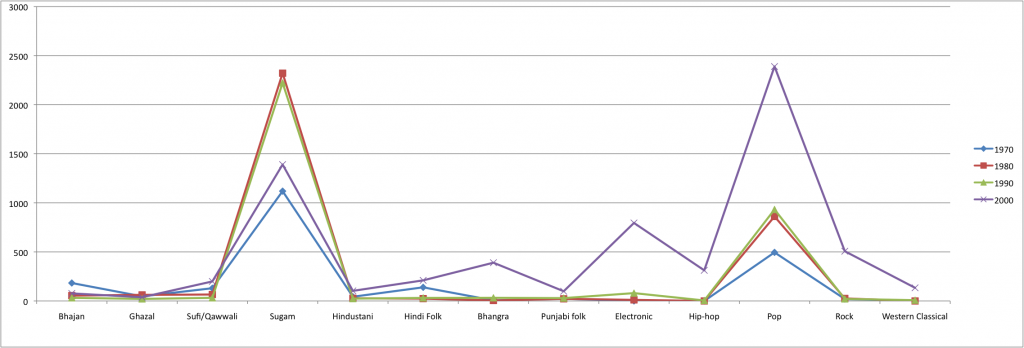Another eventful year had come to an end and it’s time to take stock of year that was for Hindi film music. We did a similar review last year, if you’re interested.
2013 saw the release of 154 films with 999 songs between them.
We lost a number of artists in 2013. Some were young and their end was unexpected – Ajay Jhingran, Rituparno Ghosh and Sandeep Acharya. Others left behind a substantial musical legacy – Lakshmi Shankar, Madhubala Zaveri, P.B. Sreenivas, Pran, Reshma, Shamshad Begum, Vaali, Vitthalbhai Patel and the last of the male singers from the classic era of Hindi films – Manna Dey.
But the show went on and a number of new artists made their debuts. While some of them were indie artists making what might just be a brief foray into Bollywood, others are probably going to be Bollywood staple in years to come. Some of the notable debuts of 2013 were:
- Composer: Advait Nemlekar, Akshay Hariharan, Atif Afzal, Bramfatura, Harpreet Singh, Indraneel Hariharan, Karan Kulkarni, The Lightyears Explode, Maatibaani, Mangesh Dhakde, Modern Mafia
- Lyricists: Ali Hayat Rizvi, Gurpreet Saini, Punam Hariharan, Ram Ramesh Sharma, Siddharth – Garima, Ubaid Azam Azmi
- Male Singers: Atif Afzal, Geet Sagar, Gopi Sunder, Indraneel Hariharan, Munawar Masoom, Najim Arshad, Nitesh Kadam, Osman Mir, Padmanabh Gaikwad, Sanam Puri, Vikas Ambhore
- Female Singers: Chaitra Ambadipudi, Jonita Gandhi, Mili Nair, Nirali Kartik, Saba Azad, Zebunnissa Bangash
The most prolific composers in 2013 were:
- Pritam – 8 films, 51 songs
- Sachin – Jigar – 7 films, 37 songs
- Sajid – Wajid – 5 films, 23 songs
While Pritam’s appearance at the top of this list is no surprise, 2013 will be seen as the year Sachin – Jigar established themselves as bankable composers and entrenched themselves in Bollywood. Surprisingly, Sajid – Wajid continue to be on this list despite their lackluster scores.
The most prolific lyricists in 2013 were:
- Kumaar – 16 films, 72 songs
- Amitabh Bhattacharya – 11 films, 42 songs
- Irshad Kamil – 5 films, 37 songs
Kumaar has been perhaps the most low profile of the current lot of lyricists so his name at this top of this list and the margin between him and the Amitabh Bhattacharya comes as a surprise.
The most prolific male singers of 2013 were:
- Mika Singh – 49 songs
- Sonu Nigam – 31 songs
- Arijit Singh – 28 songs
Mika Singh appears to be the industry’s favorite singer right now. It’s pity though that he is stuck in a rut in terms of the kinds of songs he sings. 2013 was Arijit Singh’s breakout year in terms of both the number of songs he sang as well as the mass appeal he was able to generate, thanks primarily to Ashiqui 2.
The most prolific female singers of 2013 were:
- Shreya Ghoshal and Sunidhi Chauhan – 38 songs each
- Monali Thakur, Palak Muchhal – 14 songs each
- Mamta Sharma, Shalmali Kholgade – 13 songs each
While the divas – Shreya Ghoshal and Sunidhi Chauhan – continue to dominate the scene, there seems to be a lot of competition amongst female singers. It’s good to see a newbie – Shalmali Kholgade (2012 was her debut year) on this list as it is to see Monali Thakur, who as been around for a few years now, finally get her due.
Finally, based on a combination of ratings and number of well-rated songs in 2013, the most popular artists of 2013 were:
- Most popular composers: Pritam, Amit Trivedi, Sachin – Jigar
- Most popular lyricists: Irshad Kamil, Amitabh Bhattacharya, Kumaar
- Most popular male singers: Arijit Singh, Sukhwinder Singh, Amit Trivedi
- Most popular female singers: Shreya Ghoshal, Sunidhi Chauhan, Palak Muchhal



